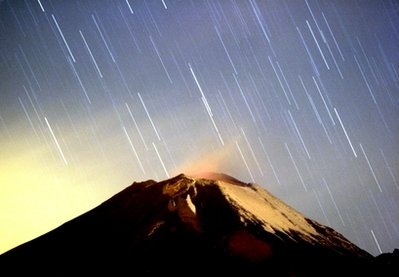Meteor Shower and Total Lunar Eclipse to Wow Skywatchers This Month
-

A meteor shower lights up the sky over the Mexican volcano Popocatepetl near the village San Nicolas …
Skywatchers, grab your blankets. December's night sky spectacular will feature the best meteor shower of 2010 as well as the only total lunar eclipse of the year – sights that should outshine any New Year's Eve fireworks display in terms of sheer wonder.
The massive Geminid meteor shower returns every year, so you'll have more chances if the cold proves too daunting on the night of Dec. 13. But anyone in North America who skips the total lunar eclipse on the night of Dec. 20 will be missing what promises to be the best lunar eclipse show until April 2014.
This year's Geminid meteor shower is expected to be the best display of so-called "shooting stars" of the year and will peak during the overnight hours of Dec. 13 and Dec. 14.
Dazzling Geminid meteor shower
Like most meteor showers, the Geminids will be at their best after midnight (early on the morning of Dec. 14), when the Earth is heading directly into the meteoroid stream. But some will be visible earlier in the night, on the evening of Dec. 13, because the meteors' radiant (where they appear to originate) is nearly circumpolar, so they will stay in view above the horizon all night.
This sky map shows where to look to see the Geminid meteor shower in the direction of the constellation Gemini. Clear dark skies, of course, promise the best viewing conditions.
Anyone venturing outside should dress much more warmly than normal to prepare for a long night vigil while sitting still.
Don't forget to get comfortable: A lawn chair with a reclining back and a blanket or sleeping bag should keep skywatchers snug — no binoculars or telescope are necessary.
Most meteor showers are caused by fragments of old comets scattered along a comet's orbit. When the Earth passes through a comet's orbit, it sweeps up the fragments, which become visible as bright streaks of light in the atmosphere.
The Geminid shower is unique in being associated not with a comet, but with an asteroid called 3200 Phaethon.
The Geminids' radiant is, as the name implies, in the direction of the constellation Gemini, just north of the northernmost of Gemini's two brightest stars, Castor and Pollux. In the early evening of Dec. 13, the radiant is low in the northeast. By 1 a.m. EST, after the date has changed to Dec. 14, the radiant is almost directly overhead. By 6.a.m. EST, when the shower is at its peak in the Eastern Time Zone, the radiant is low in the west.
Moon's holiday treat
The December holiday sky show doesn't end with the Geminid meteor shower. On the nights of Dec. 20 and Dec. 21, parts of four continents will be treated to a total eclipse of the moon — the only one to occur in 2010.
This NASA lunar eclipse chart shows the visibility of the eclipse from different regions around the world.
The last total lunar eclipse occurred on Feb. 20, 2008. While there are two total lunar eclipses in 2011, North American skywatchers will have to wait until April 2014 for one as potentially spectacular as the eclipse occurring this month. [Amazing Total Lunar Eclipse Photos]
Lunar eclipses occur when the moon passes through a point in its orbit in which the Earth is directly between it and the sun. When the moon enters the shadow of Earth, it creates a lunar eclipse. Unlike a solar eclipse, no precautions to protect the eyes are needed.
A total lunar eclipse is when the entire moon is completely inside the Earth's shadow. Since the sun's rays are bent by Earth's atmosphere so that some still reach the moon, the moon is still visible in an eclipse.
Lunar eclipse skywatching tips
For the Western Hemisphere, the eclipse will "officially" begin on Dec. 21 at 12:29 a.m. EST (9:29 p.m. PST on Dec. 20) as the moon begins to enter Earth's outer, or penumbral, shadow.
As for the Geminid meteor shower, don't forget to dress warm. But you won't be outside all night moongazing. This total lunar eclipse lasts only 72 minutes from start to finish.
But even in clear weather, skywatchers will not notice any changes in the moon's appearance until about 45 minutes into the event, when a slight "smudge," or shading, begins to become evident on the upper left portion of the moon's disk.
The entire total lunar eclipse will be visible from all of North and South America, the northern and western parts of Europe, and a small part of northeast Asia, including Korea and much of Japan.
Totality will also be visible in its entirety from the North Island of New Zealand and Hawaii. In all, an estimated 1.5 billion people will have an opportunity to enjoy the best part of this lunar show.
In other parts of the world, only the partial stages of the eclipse will be visible or the eclipse will occur when it's daytime and the moon is not above their local horizon.
Portions of western Africa and central Europe can catch the opening stages of the eclipse before the moon sets below the horizon during the morning hours of Dec. 21, while the eastern third of Asia and central and eastern Australia can catch the closing stages just after moonrise on the evening of Dec. 21.
December's total lunar eclipse and Geminid meteor shower promise to ring the year 2010 out with a dazzling show, weather permitting, this holiday season. But bundle up and stay warm!
-
Thanks for that, LB!
I'll keep an eye out.